Vol 8 No 4 2023 – 49
Evaluation of the growth efficiency of some citrus rootstocks for spraying melatonin growth regulator under salt stress conditions
Muntadher Al-Mousawi 1*, Harith Al-Tamimi1
1 College of Agriculture/ Department of Horticulture and Landscape/ University of Kerbala, Karbala/Iraq; muntadher.m@uokerbala.edu.iq.
2 College of Agriculture/ Department of Horticulture and Landscape/ University of Kerbala/ Karbala/Iraq; harith.mhmod@uokerbala.edu.iq
* Correspondence: muntadher.m@uokerbala.edu.iq; Tel.: 009647714910387
Available from. http://dx.doi.org/10.21931/RB/2023.08.04.54
ABSTRACT
This research was conducted to determine the impact of spraying the increased regulator melatonin on the tolerance of some citrus roots to salt stress. The results showed that the Sour Orange root was significantly superior to the rest of the citrus rootstocks and recorded the highest increase in the rate (Height, diameter, quantity, and area of leaves for the plant), while the root Volkamer lemon was significantly the best by recording the highest rate of arid mass of the root system and plant life. Furthermore, irrigation with electrical connection water (1.7 sec.m-1) led to obtaining the highest values for vegetative plant girth growth characteristics (plant girth, stem diameter, number of leaves, leaf area, dry weight of the vegetative and root system and root length). Moreover, treatment with the growth regulator melatonin at a concentration of (100 mg.L-1) showed the most significant percentage in the trait (plant height, diameter of the stem, number of leaves, size of the leaves, and dry weight of the vegetative both root system and root length). As well as the binary and triple interactions between these study factors led to a clear significant superiority in the studied traits compared to the comparison treatment, as the triple interaction treatment (Sour Orange root + melatonin at 100 mg. l-1 as the concentration+ salinity of irrigation water at a concentration of 1.7 decimens.m-1) was the most significant treatment by giving the highest increase in the rate of vegetative characteristics. Finally, the treatment (rootstocks Volkamer lemon + melatonin at 100 mg.l-1 as the concentration + salinity of irrigation water at a concentration of 1.7 dm. m-1) recorded the highest rate of length and weight of the root when it is a dry system.
Keywords: melatonin; rootstocks; salinity
INTRODUCTION
The problematic issue related to salinity, whether soil or irrigation water, is one of the most critical obstacles to the development of agricultural production in general and citrus production in particular. This is mainly in the dry and semi-arid regions of the world, as rainfall decreases and temperatures rise, and agriculture depends mainly on irrigation 1. It leads with time to the accumulation of salts in the soil, thus becoming saline and decreasing its suitability for agriculture, knowing that 20-30% of the world’s land is affected by salinity 2. As for Iraq, the estimation was 3, indicating that 70-80% of the center’s and the south’s lands are within the medium to highly saline soils. It is well-known that the salinity reduces the growth and production of plants. This is due to the damage caused to the integrity of the cell membranes due to the osmotic effect, disruption of the hormonal and enzymatic balance, and the toxic effect of ions 4. Citrus fruits are classified as sensitive plants to high salinity, and the degree of their impact varies according to the roots grafted on them 5.
Additionally, it was mentioned 6 that the rootstocks of citrus fruits differ significantly in their tolerance to salinity and the absorption and transfer of harmful ions from the roots to the vegetative system by excluding or restricting them in the lower parts of the plant. Therefore, searching for solid assets that are resistant to various soils and tolerant of salinity is one of the very important objects in Iraq. This is especially true with the scarcity of water suitable for irrigation and the dependence of farmers on water from wells and sewers to irrigate their orchards.
Sour orange of the Sour Orange L. is a standard rootstock used in Iraq. This is because it was characterized as a semi-shortened root compatible with most commercial cultivars of citrus, tolerant of limestone soils, medium resistance to cold, and resistance to root rot and gum disease. However, it can be infected by Tristeza disease and nematodes 7. The rootstock Volkamer lemon (Citrus reticulate X Citrus medica) is characterized by its rapid growth and stimulating effect on the growth of grafts and adaptation to a wide range of soils, mainly sandy soils, resistant to Tristeza, exocortis and xyloporosis. However, it is sensitive to nematodes. On the other hand, the rootstock Swingle Citrumelo (Citrus paradise X Poncirustrifoliata) has been used recently in Iraq, which is characterized by its drought tolerance, medium tolerance to salinity and its resistance to severe cold of a large extent due to the large variety of rootstock8. It is also considered a root resistant to Tristeza, exocortis, xyloporosis, root rot and nematode infection 9.
In recent years, plant hormones have attracted the attention of many researchers in the field of environmental stresses as one of the most critical actors in stimulating the response of plants to carry out biological processes. Many studies have shown that adding plant hormones in low concentrations to plants exposed to salt stress has an influential role in overcoming the harmful effects of salt stress in plants 10, 11, 12. Among the plant hormones regulating growth is melatonin, which can be utilized during soaking the seeds or spraying it on the plant shoots. Melatonin was first identified in 1995, and since then, extensive research has revealed the physiological roles that melatonin plays in plants 13. Most studies have shown that melatonin regulates seed germination, rooting, flowering, and photosynthesis and delays aging 14;15. Several recent studies showed that adding malatotin to cucumber, maize and tomato helped reduce salinity’s effect and the plant’s tolerance to salt stress and improved growth 18, 17; 16.
Few studies have examined the impact of the growth regulator on melatonin in increasing the tolerance of citrus roots to salinity. Thus, this research aims to evaluate the efficiency of citrus root growth under salt stress conditions and the growth regulator’s impact on melatonin in reducing the damage caused by salinity to citrus roots.
MATERIALS AND METHODS
The experiment took place in the Vegetable University of California, Davis, College of Agriculture, Department of Horticulture and Landscape Kerbala from March to the middle of June of October 2021. Seedlings of three citrus rootstocks (162) were selected with solid growth obtained from the Horticultural and Forestry station / Al-Hindia district/ Karbala Province and planted in polyethylene bags (1.25 kg). They were transferred on 15/2/2021 to 10 kg bags filled with sandy mixture. A factorial experiment (3 x 3 x 3) was followed utilizing a random complete three-block design (R.C.B.D.) replications, as each replicate contains (27) treatments with 3 seedlings for each experimental unit. The second was irrigation with three different saline concentrations (1.7, 4 and 8 decimens.m-1) at an irrigation rate every week, while the third factor was spraying with the growth control melatonin utilizing three concentrations (0,50 and 100 mg.l-1) starting from 3/15/ 2021 and until 9/15/2021 at a rate of one spray every 30 days until complete wetness. Measurements of several traits were taken on 1/10/2021 as follows:
· Plant height (cm).
· Stem diameter (cm).
· Number of leaves (leaf. plant-1).
· Leaf area (cm2): The leaf area was calculated using the described method (19).
· Then, the shoot’s dry weight (gm).
· The length of the root (cm).
· The shoot’s dry weight system (gm).
RESULTS
Rate plant height (cm)
Table (1) shows that the root has a notable impact on the plant height rate, where the Sour Orange Root outperformed by providing the highest rate in plant height (85.96 cm) compared to the rest of the assets, while the rootstock Sour Orange recorded the lowest significant difference of (63.72 cm). As for melatonin, it is noted from the same Table that Increasing the concentration caused a significant increase in the plant height characteristic, as the concentration (100 mg. L-1) surpassed it by giving the highest rate of plant height reached (82.83 cm), while melatonin recorded at a concentration (0 mg. L-1) the least significant difference amounted to (63.76 cm).). The salinity of the irrigation water was recorded at a concentration of (1.7 decimens.m-1). The highest rate of plant height was (82.74 cm), while the concentration (8 decimens.m-1) gave the lowest rate of (63.91 cm). The results also indicate significant differences in Volkamer lemon for the binary interactions between the treatments, as the results of the same Table showed that the binary interactions between the rootstock and melatonin significantly affected the plant height rate. ) compared to the other treatments, while the interaction treatment (rootstock Swingle Citrumelo + melatonin at a concentration of 0 mg. L-1) recorded the lowest value in the average plant height, which was (58.94 cm). The results of the binary interaction between the rootstock and the salinity of the irrigation water in the plant height trait showed that there were significant differences, where the treatment (Sour Orange root + the salinity of the irrigation water at a concentration of 1.7 dSm-1) outperformed by recording the highest rate of plant height of (97.94 cm) compared to the dual interaction treatment (root + The salinity of the irrigation water with a concentration of 8 dSm-1), which gave the least significant difference of (55.44 cm). As for the bilateral interaction between melatonin and salinity, the results showed significant differences between the two treatments, where the treatment (melatonin at an intensity of 100 mg.l-1 + irrigation water salinity at a concentration of 1.7 decimens.m-1) outperformed the treatment by recording the highest rate of plant height of (94.00 cm), while The dual-interaction treatment (melatonin at a concentration of 0 mg. L-1 + the salinity of irrigation water at a intensity of 8 decimens. m-1) recorded the lowest average plant height of (53.89 cm). As for the triple interaction treatment, the results of the same Table indicate the superiority of the treatment (Sour Orange root + melatonin at an intensity of 100 mg. L-1 + irrigation water salinity at an intensity of 1.7 decimens. m-1) by providing the best rate in plants height that reached (111.88 cm) compared to the triple interaction treatment (rootstock Volkamer lemon + melatonin at a concentration of 0 mg L-1 + the salinity of irrigation water at a concentration of 8 dm-1), which recorded the smallest percentage of (49.67 cm).
Rate Stem diameter (mm)
The results presented in Table (2) show that the single treatments had a significant effect on stem diameter, where the Sour Orange root was superior by giving the highest significant difference to the stem diameter of the plant, amounted to (8.214 mm) compared to the rest of the assets. It is noted in the same Table that the rise in concentration has caused a significant increase in the character of the stem diameter, as the concentration (100 mg. L-1) outperformed by giving the highest average of stem diameter reached (8.127 mm), while the melatonin recorded at a concentration (0 mg. L-1) the lowest diameter of the plant It reached (6.270 mm). As for the salinity of irrigation water, the treatment recorded an intense level of (1.7 decimens.m-1) the highest rate of plant stem diameter was (7.639 mm), while the concentration (8 decimens.m-1) recorded the lowest rate of (6.906). Mm). The results of the same Table showed that the bilateral interactions between the root and melatonin had a significant effect on the average stem diameter. The treatment (Rootstock citrus + melatonin at an intensity of 100 mg. L-1) outperformed by recording the highest rate of stem diameter of (9.244 mm) compared to the interaction treatment recorded. Swingle Citrumelo + melatonin at a concentration of 0 mg. l-1) the lowest rate was (5.101 mm). The results of the bilateral interactions between the rootstock and the salinity of the irrigation water showed a significant effect on the average stem diameter, as the treatment (Sour Orange root + the salinity of the irrigation water at a concentration of 1.7 dS. m-1. The interaction treatment (rootstock Volkamer lemon + salinity of irrigation water at a concentration of 8 decimens.m-1) had the lowest average (5.384 mm). As for the bilateral interaction between melatonin and salinity of the irrigation water, the same Table shows the superiority of the treatment (melatonin an accumulation of 100 mg. l-1 + salinity). Irrigation water at a concentration of 1.7 decimens.m-1) recorded the highest average stem diameter of (8.712 mm). In comparison, the dual interaction treatment (melatonin at a concentration of 0 mg. l-1 + salinity of irrigation water an accumulation of 8 decimens.m-1) gave the lowest value of (5.844 mm).
The same Table shows that the triple interaction between the study factors (rootstock, melatonin and irrigation water salinity) showed significant differences for stem diameter, as the treatment (Sour Orange root + melatonin at a concentration of 100 mg.l-1 + salinity of irrigation water an accumulation of 1.7 decimens.m-1) excelled by giving the highest rate It reached (9.477 mm), while the triple interaction treatment (rootstock Volkamer lemon + melatonin at a concentration of 0 mg.l-1 + salinity of irrigation water an accumulation of 8 decimens.m-1) recorded the smallest percentage of (4.908 mm).
Rate number of leaves per plant (leaf. plant-1)
It is noted from the results shown in Table (3) that the Sour Orange root outperformed the rest of the roots in the number of leaves by giving the highest rate of (77.09 leaves. Also, melatonin was superior at the concentration (100 mg. L-1) by giving the highest rate of the number of leaves reached (76.41 leaves. plant-1), while the concentration (0 mg. L-1) gave the lowest rate of (65.02 leaves. plant-1). The results also decreased the number of leaves with an increase in the salinity of the irrigation water concentration, and the concentration treatment (1.7 decimens.m-1) outperformed by recording the highest rate for the number of leaves trait amounted to (88.63 leaves. The average rate number of leaves was (52.76 leaves. Plant-1). The results of the same Table show that there is a significant effect of the bilateral interaction between the rootstock and melatonin, where the treatment (Sour Orange + melatonin at an intensity of 100 mg.L-1) outperformed by recording the highest rate in the number of leaves that reached (80.06 leaves.Plant-1) compared to the other treatments, while the treatment recorded The interaction (Volkamer lemon root + melatonin at an intensity of 0 mg.L-1) had the lowest rate in the number of leaves per plant was (60.22 leaves. Plant-1). As for the dual interaction between the rootstock and the irrigation water salinity, the treatment (Sour Orange root + the salinity of the irrigation water at an intensity of 1.7 dSm-1) was superior. m-1) recorded the highest number of leaves (91.56 leaves. -1). The results also showed the superiority of the treatment (melatonin at an intensity of 100 mg. L-1 + irrigation water salinity at an intensity of 1.7 dm.m-1) by recording the highest rate in the number of leaves that reached (93.67 leaves. plant-1). In contrast, the dual interaction treatment was recorded. (Melatonin at a concentration of 0 mg. L-1 + the salinity of irrigation water at an intensity of 8 dm-1) the lowest rate was (46.44 leaves. Plant-1). The results of the statistical analysis in Table (5) showed that there were significant differences between the triple interaction between the root and melatonin and the salinity of the irrigation water, as the treatment (Sour Orange root + melatonin at an intensity of 100 mg. l-1 + salinity of the irrigation water at an intensity of 1.7 decimens.m-1) excelled by giving the highest significant difference in the average number of leaves reached (95.17 leaves. plant-1). In comparison, the triple interaction treatment (rootstock Volkamer lemon + melatonin at an intensity of 0 mg. l-1 + salinity of irrigation water at an intensity of 8 decimens.m-1) recorded the least significant difference in the average number of leaves per plant was (39.67 leaves. Plant-1).
Leaf area (cm2)
Table (4) shows the effect of the root and melatonin and the salinity of irrigation water and the interaction between them on the rate leaf area, as the Sour Orange excelled by giving the highest rate of leaf area during the growing season amounted to (1692 cm2) compared to the rootstock Swingle Citrumelo (1221 cm2). The results also show that the use of the growth regulator melatonin, on the one hand, had a significant effect in increasing the leaf area rate, where the concentration treatment (100 mg.L-1) was superior by giving the highest rate of (1603 cm2) compared to the comparison treatment, which gave the lowest rate (1161 cm2). As for the irrigation water salinity, the treatment was recorded at a concentration (of 1.7 decimens.m-1). The highest rate leaf area was (2114 cm2) compared to treatment at a concentration (of 8 decimens.m-1), which gave the lowest average, which amounted to (798 cm2). The binary interactions between (rootstock and melatonin), (rootstock and irrigation water salinity) and (melatonin and irrigation water salinity) showed a significant effect on the average leaf area. The treatment (Citrus aurantium root + melatonin at an intensity of 100 mg.L-1) gave the highest average leaf area of (1876 cm2) compared to the other treatments, and the interaction treatment (Swingle Citrumelo rootstock + melatonin at an intensity of 0 mg.L-1) which gave the lowest rate of (995 cm2). As for the bilateral interaction between the rootstock and the salinity of the irrigation water, the treatment (Sour Orange root + the salinity of the irrigation water at an intensity of 1.7 decimens.m-1) was superior by giving the highest rate of (2541 cm2). The treatment of the twofold interaction was recorded with the (Swingle Citrumelo root + the irrigation water salinity at an intensity of 8 decimens). m-1), the lowest average leaf area was (667 cm2). Table (6) shows the superiority of the treatment of (melatonin at an intensity of 100 mg.l-1 + the salinity of irrigation water at a concentration of 1.7 decimens.m-1) by recording the highest rate in leaf area that reached (2376 cm2) compared to the rest of the treatments. It gave the recorded treatment (melatonin at an intensity of 0 mg. l– 1 + salinity of irrigation water at a concentration of 8 decimens.m-1) the lowest average leaf area was (613 cm2). As for the triple interaction between the rootstock and melatonin and the salinity concentration, the treatment (Sour Orange root + melatonin at a concentration of 100 mg.l-1 + the salinity of irrigation water at a concentration of 1.7 decimens.m-1) gave the highest average leaf area that reached (2848 cm2), followed by the treatment (Sour Orange + melatonin at a concentration of 50 mg.l-1 + salinity of irrigation water at a concentration of 1.7 decimens.m-1) which gave (2695 cm2), while the triple interaction treatment was recorded (rootstock Volkamer lemon + melatonin at an intensity of 0 mg.l-1 + salinity of irrigation water at a concentration of 8 decimens.m– 1) The lowest value in the leaf area of a plant was (511 cm2).
Rate dry weight of the shoot (gm)
The results presented in Table (5) show that the single treatments significantly affected the vegetative group’s dry weight rate, where the Volkamer lemon outperformed by giving the highest amount of (29.38 g) compared to the rest of the roots. As for melatonin, it was noted that the concentration (100 mg. L-1) was superior by giving the highest rate in the dry weight of the vegetative total of the plant, which amounted to (28.18 g) compared to the comparison treatment that recorded the lowest rate of (24.84 g). As for the salinity of irrigation water, a treatment was recorded at concentration. (1.7 decimens.m-1), the highest rate was (34.72 g). In comparison, the salinity of irrigation water treatment at a concentration (8 decimens.m-1) recorded the lowest rate in the dry weight of the vegetative total was (21.69 g). The results of the same Table also showed that the bilateral interactions between the root and melatonin had a significant effect, as the treatment (Volkamer lemon + melatonin at an intensity of 100 mg. L-1) outperformed the treatment by recording the highest rate in the dry weight of the shot total (31.27 g) compared to the other treatments.
In comparison, the interaction treatment was recorded (rootstock Swingle Citrumelo + melatonin at an intensity of 0 mg. L-1). The lowest rate was (22.56 g). As for the binary interaction between the rootstock and salinity, the treatment (Volkamer lemon root + salinity of irrigation water at an intensity of 1.7 ds.m-1) was superior by recording the highest rate in the dry weight of the shot total (36.75 g) compared to the treatments, and the interaction treatment gave (Rootstock Swingle Citrumelo + water salinity Irrigation at an intensity of 8 dm-1) the lowest rate was (18.55 g). The dual interaction treatment in the same Table indicates the superiority of the treatment (melatonin at an intensity of 100 mg. l-1 + salinity treatment at an intensity of 1.7 decimens.m-1) by recording the highest rate in the dry weight of the shot total (36.75 g), compared to the treatment of the dual interaction (melatonin at a concentration of 0 mg) L-1 + salinity of irrigation water at an intensity of 8 decimens.m-1), the lowest average ton was (19.91 g). The triple interaction between the study factors (rootstock, melatonin and water salinity) significantly increased the shoot population’s dry weight rate. The treatment of Sour Orange root + melatonin at an intensity of 100 mg. l-1 + salinity treatment at an intensity of 1.7 ds.m-1) achieved the highest rate. The dry weight of the shoots was (39.20 g), while the treatment (Swingle Citrumelo + melatonin at an intensity of 0 mg. L-1 + irrigation water salinity at an intensity of 8 dS. m-1) recorded the lowest rate of (18.03 g).
Rate root length (cm)
Table (6) shows no significant differences between the rootstocks in the characteristic of root length. When using the growth regulator melatonin, it was noticed that the root length increased with the increase in the concentration, where the treatment at an intensity of (100 mg. L-1) was superior by giving the highest rate in root length of 36.41 cm. In contrast, the comparison treatment recorded the lowest rate in root length of (34.07 cm). As for the salinity of the irrigation water, the treatment at a concentration (1.7 decimens.m-1) recorded the highest rate of (39.74 cm), while the concentration (8 decimens.m-1) recorded the lowest rate in root length of the plant reached (30.59 cm). The results in the same Table also indicate that there are significant differences in the bilateral interactions between treatments in the characteristic of root length rate, where the treatment (Sour Orange root + melatonin at an intensity of 100 mg. L-1) was superior by recording the highest rate in root length of (37.44 cm) compared to the other treatments.
In comparison, it was recorded. The interaction treatment (Sour Orange root + melatonin at an intensity of 0 mg. L-1) had the lowest average (32.78 cm). As for the bilateral interaction between the rootstock and the salinity of the irrigation water, the treatment (Volkamer lemon root + irrigation water salinity at an intensity of 1.7 decimens.m-1) achieved the highest rate in the root length of the plant reached (41.33 cm) compared to the other treatments. In comparison, the interaction treatment was recorded (Volkamer lemon + The irrigation water salinity was at a concentration of 8 decimens.m-1), with the lowest rate (26.78 cm). The dual interaction treatment (melatonin at an intensity of 100 mg. l-1 + salinity of irrigation water at a concentration of 1.7 decimens.m-1) showed the highest rate in the plant’s root length reached (42.00 cm). In comparison, the dual interaction treatment (melatonin at an intensity of 0 mg. l-1+) was recorded. The salinity of the irrigation water at an intensity of 8 decimens.m-1) was the lowest average for the plant’s leaf area (29.67 cm). The results of the statistical analysis in Table (6) showed that there were significant differences for the triple interaction, where the treatment (rootstock Volkamer lemon + melatonin at an intensity of 100 mg. l-1 + salinity of irrigation water at an intensity of 1.7 decimens.m-1) outperformed by giving the highest rate of (42.67 cm). The triple interaction treatment (rootstock Volkamer lemon + melatonin at an intensity of 0 mg. l-1 + irrigation water salinity at an intensity of 8 decimens.m-1) recorded the lowest value in root length of (25.00 cm).
Rate dry weight of the root system (gm)
Table (7) shows that the root had a significant effect on the rate dry weight of the root system, as the rootstock of Volkamer lemon was superior by giving the highest rate dry root weight of the plant amounted to (17.20 g) compared to the rest of the roots.). As for the growth regulator, melatonin, the concentration treatment (100 mg. L-1) outperformed by giving the highest rate in the dry weight of the root system (16.07 g) compared to the comparison treatment, which recorded the lowest rate (13.12 g). (1.7 decimens.m-1) the highest rate was (19.83 g) compared to the concentration treatment (8 decimens.m-1), which gave the lowest rate (10.22 g). The bilateral interaction between the study factors shown in Table (7) had a significant effect on the average dry weight of the root group, as the treatment (Volkamer lemon root + melatonin at an intensity of 100 mg.L-1) outperformed by recording the highest rate in the dry weight of the root group amounted to (18.86 g) compared to the treatments The other and the interaction treatment (Swingle Citrumelo + melatonin at an intensity of 0 mg.l-1) gave the lowest rate of (10.25 g). Also, the treatment (rootstock Volkamer lemon + salinity treatment at an intensity of 1.7 decimens.m-1) produced the highest average in the dry weight of the total The root total amounted to (24.52 g) compared to the other treatments, and the treatment (Swingle Citrumelo + irrigation water salinity at an intensity of 8 decimens.m-1) recorded the lowest average dry weight of the root total amounted to (8.40 g). The same data also indicates the superiority of the dual interaction treatment between melatonin. When treated, the salinity of the irrigation water (melatonin at a concentration of 100 mg. l-1 + salinity treatment at an intensity of 1.7 decimens.m-1) recorded the highest average in the dry weight of the rootstock reached (21.59 g). In comparison, the dual interaction treatment (melatonin at an intensity of 0 mg. l-1) was recorded. + salinity of irrigation water at an intensity of 8 decimens.m-1) the lowest rate was (8.85 g). As for the triple interaction combined among the study factors, the treatment (Volkamer lemon root + melatonin at an intensity of 100 mg. L-1 + salinity of irrigation water at an intensity of 1.7 dS. m-1) was superior in giving the highest rate in the dry weight of the root total of (27.29 g), while the interaction treatment recorded the triple (rootstock Swingle Citrumelo + melatonin at a concentration of 0 mg. l-1 + the salinity of irrigation water at an intensity of 8 dm.m-1) had the lowest value of (3.74 g).
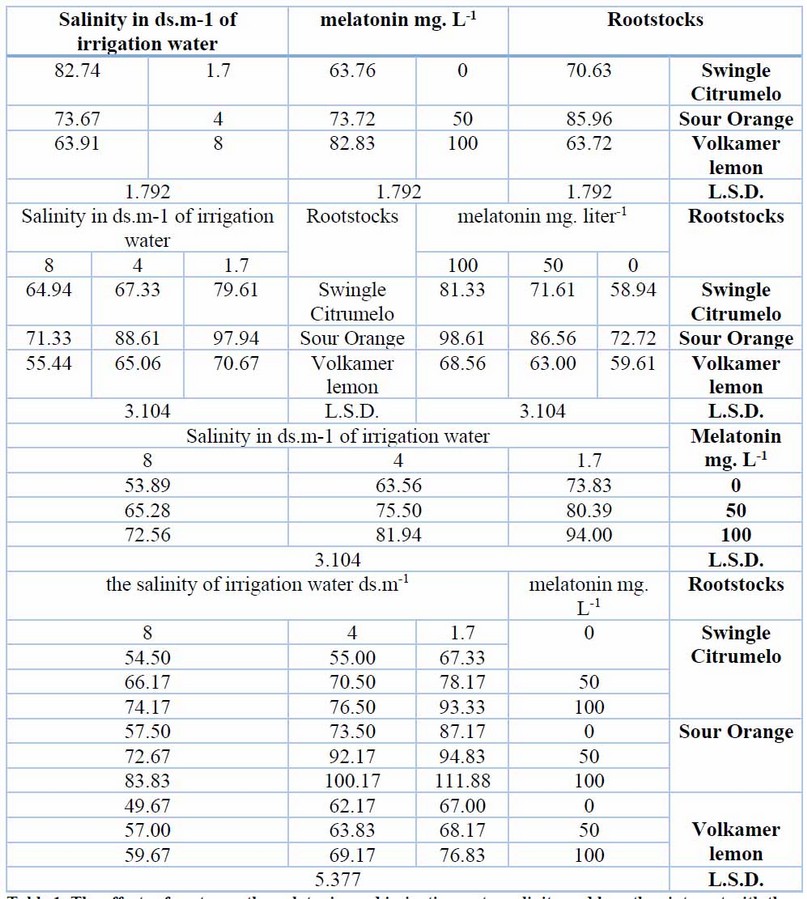
Table 1. The effects of root growth, melatonin, and irrigation water salinity and how they interact with the rate in plant height (cm).
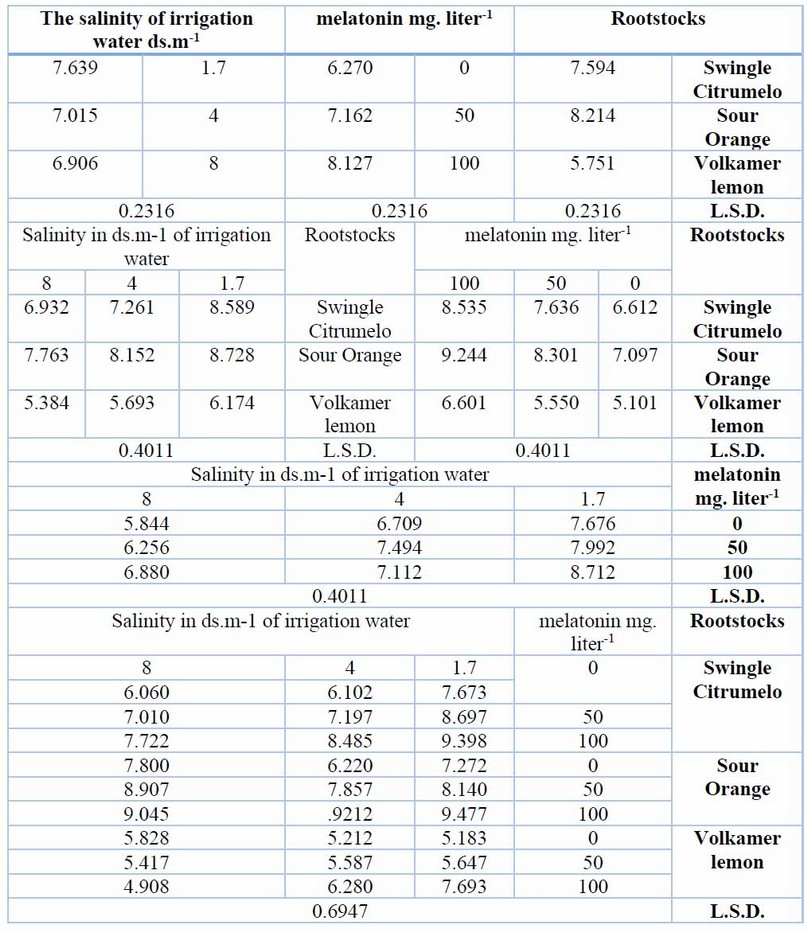
Table 2. The effect of root growth, melatonin salinity of irrigation water, and how they impact rate stem diameter (mm).
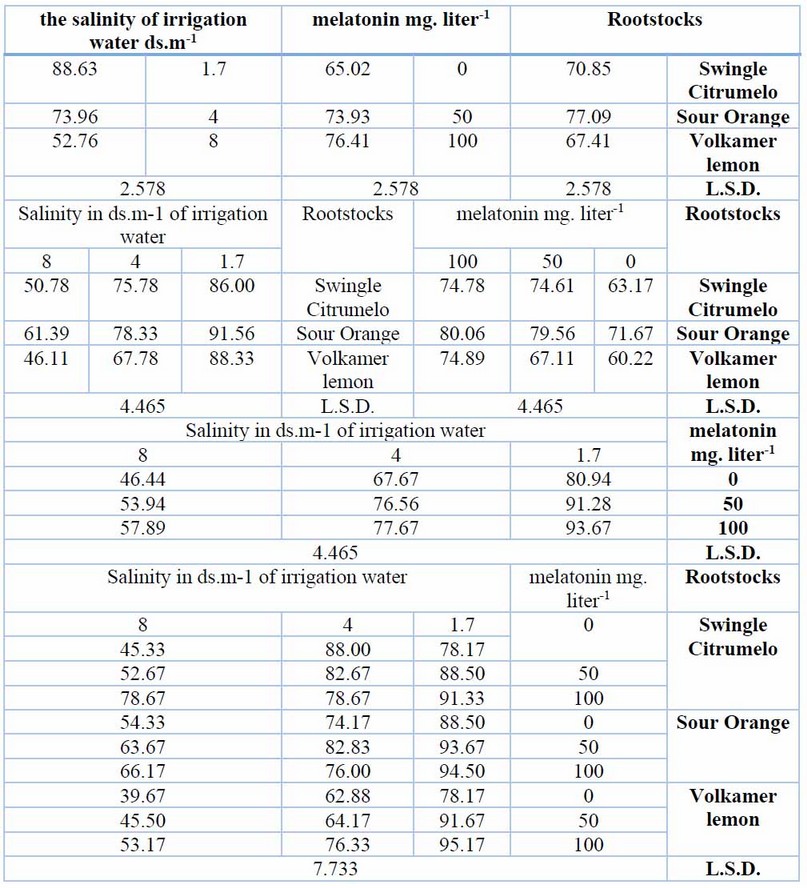
Table 3. The effects of root growth, melatonin, and irrigation water salinity on the leaf growth rate (leaf. plant-1).
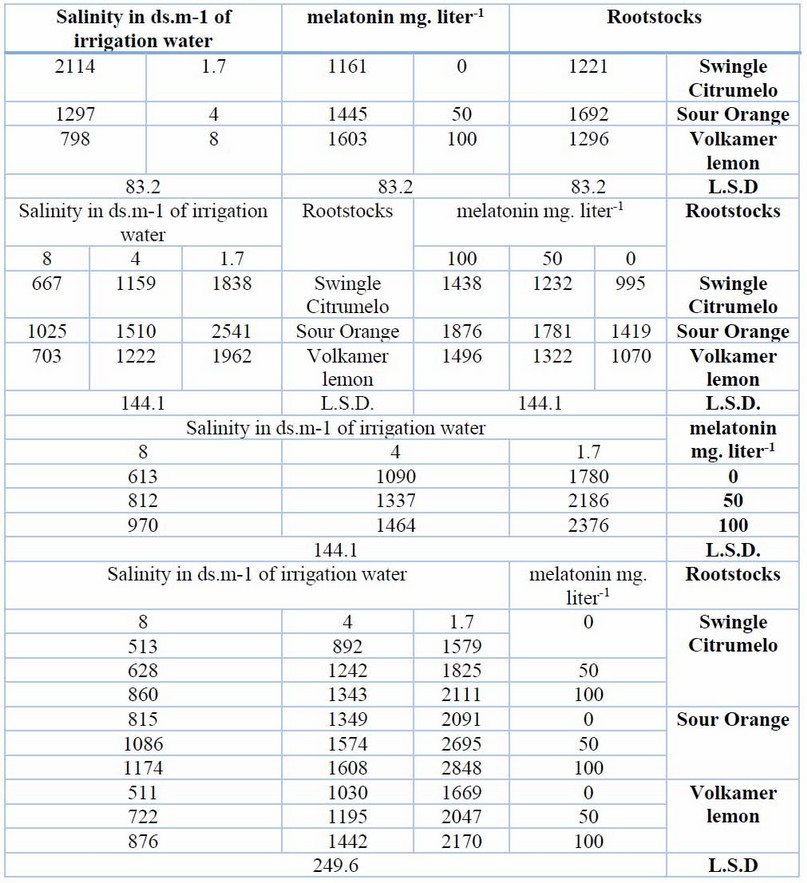
Table 4. The effect of root growth, melatonin salinity of irrigation water, and how they impact rate leaf area (cm2).
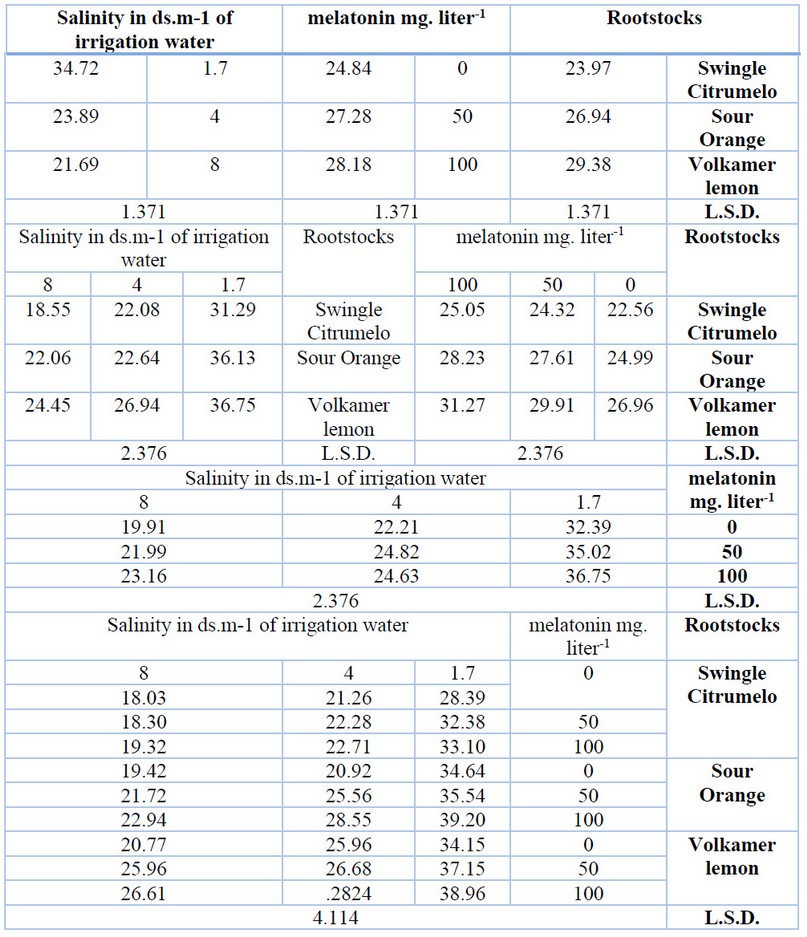
Table 5. The effects of root growth, melatonin, and irrigation water salinity on the shoot’s dry weight rate (gm).
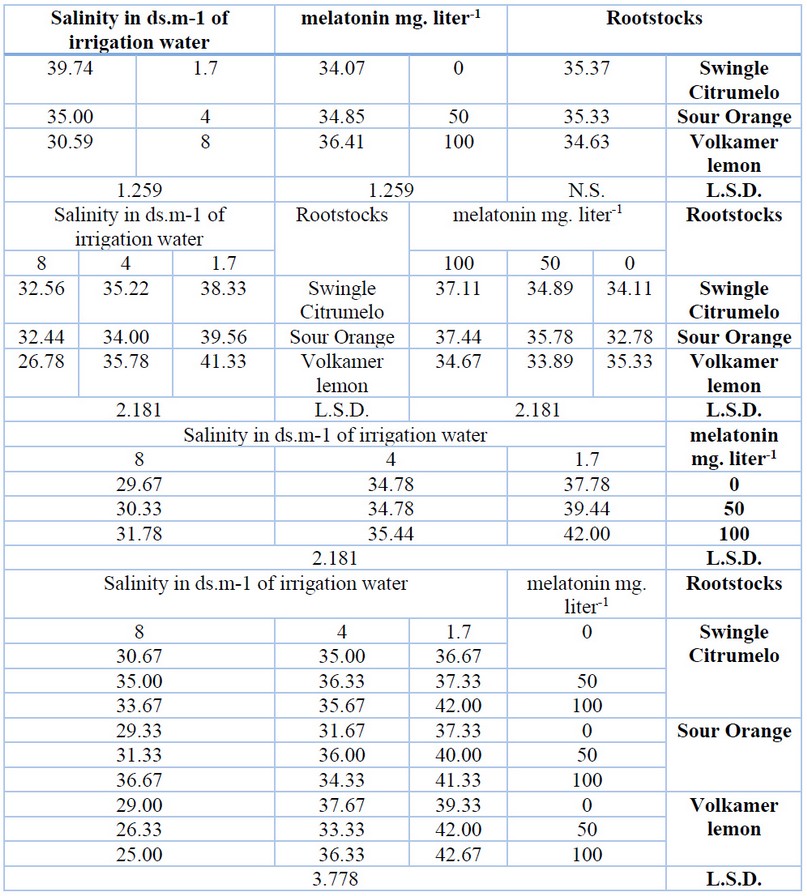
Table 6. The effect of melatonin on root growth, the salinity of irrigation water, and how they impact the rate of root length (cm).
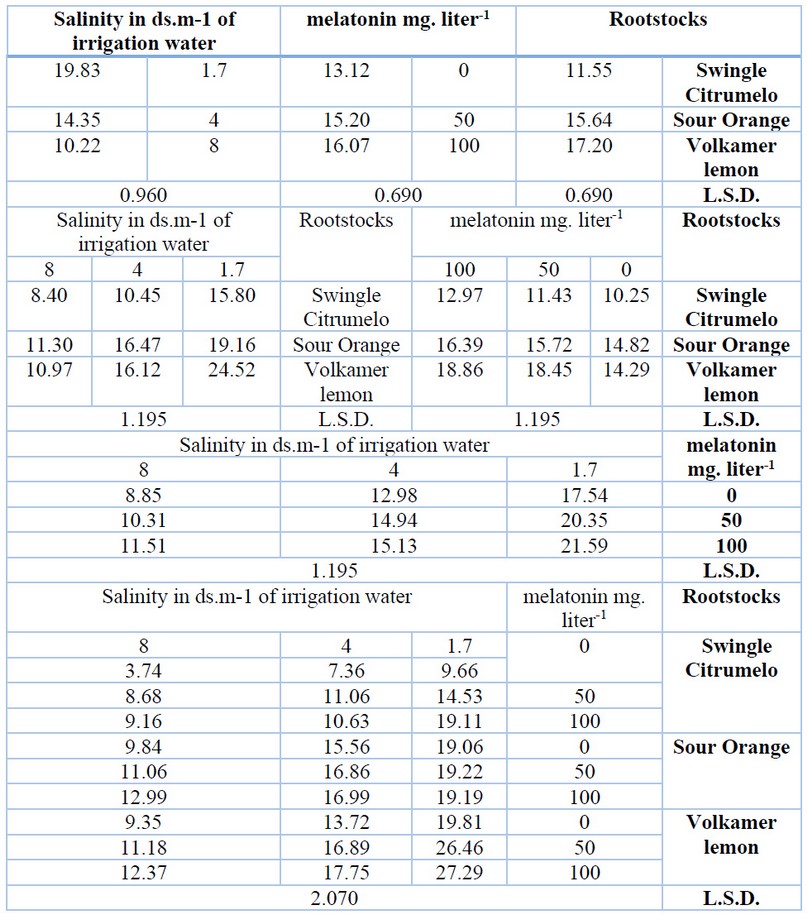
Table 7. The effect of root growth, melatonin, the salinity of irrigation water, and how they impact the rate dry weight of the rootstock (gm).
DISCUSSION
The results above indicate differences between the citrus rootstocks (Swingle Citrumelo, Sour orange, and Volkamer lemon) exposed to salt stress in vegetative and root characteristics. Especially the sodium and chloride ions, thus increasing the readiness for absorption of nutrients in the origin area and how they affect the leaves, improving cells’ osmotic pressure and reaching a hormonal and nutritional state balance by preserving a high potassium-to-sodium ion ratio, one of the key elements for salinity tolerance. 20. It was shown 21 that the ability of citrus trees to tolerate salinity depends on the possibility of their origin in restricting the absorption and transfer of harmful salt ions to the vegetative system. The results also showed that spraying with the growth regulator melatonin with different concentrations had a significant effect in improving the vegetative and root characteristics of seedlings under salt stress conditions, perhaps due to the role of melatonin similar to the effect of auxin indole-3-acetic acid (I.A.A.) in promoting cell division and elongation and Delaying leaf aging, stimulating photosynthesis, and maintaining the integrity of cell membranes and chlorophyll pigment from demolition under salt stress conditions 22 and 23. It was mentioned 24 that melatonin and I.A.A. are synthesized inside the plant from the amino acid tryptophan. 25It was found that the addition of melatonin increases the levels of auxin inside the plant by stimulating the auxin flux proteins AUXIN1/LIKE-AUX1 (AUX/LAX) essential in the manufacture of I.A.A., or perhaps the reason is due to the role of melatonin in protecting the plant from abiotic stresses either directly By scavenging or removing free radicals or by stimulating enzymatic antioxidants such as Peroxidase (P.O.D.), Superoxide Dismutase (S.O.D.) and Catalase (C.A.T.) and non-enzyme such as ascorbic acid, glutathione, and flavonoids, thus protecting enzymes from oxidative damage and enhancing the efficiency of the chain Transfer of electrons and reduce their leakage in the mitochondria and thus reduce the content of free radicals within the plant 26, 27. 28 It was found that spraying Sour orange L with melatonin irrigated with saline water at a concentration of 100 mmol NaCl caused a significant increase in the carbohydrate content of the leaves and the antioxidant activity (S.O.D., P.O.D. and C.A.T.) and glutathione. 29 It was found that spraying grape seedlings Vitis vinifera var. Xiahei with melatonin at a concentration (200 mmol) caused an increase in the activity of enzyme antioxidants (S.O.D., P.O.D. and C.A.T.) and the dry weight of the shoot and root system. The decrease in the growth of citrus roots, in general, with the increase in salt concentrations in the irrigation water, may be due to the high salinity causing a decrease in the water potential of the plant and thus reducing the expansion of cells and the speed of their division and the closing of the guard cells of the stomata and the decrease in the process of gas exchange and photosynthesis, which is reflected Negatively on growth and other metabolic processes and the accumulation of organic matter 30. High salinity also causes poor root growth and production of cytokinins, which are transmitted through the plant sap and stimulate the growth of the vegetative system. Alternatively, perhaps the reason is that the high salinity leads to inhibition of the production of growth inhibitors and reduces the activity of the meristematic tissue of the cambium, which causes a decrease in the size of the new meristematic cells and the lack of their transformation into adult cells 31.
According to the outcomes of this study, it is possible to irrigate citrus roots with electrical conduction water (8 dSm-1) and spray with a melatonin growth regulator at a concentration of 100 mg. l-1 to reduce the damage of high salinity to plants.
CONCLUSIONS
Sour orange rootstock was significantly superior to the rest of the citrus rootstocks and recorded the highest increase in the rate (plant height, stem diameter, number of leaves and leaf area), while the rootstock Volkamer lemon was significantly superior by recording the highest rate of dry weight of the vegetative and root system. Irrigation with electrical connection water (1.7 decimens.m-1) led to obtaining the highest values for vegetative and root growth characteristics (plant height, stem diameter, number of leaves, leaf area, dry weight of the vegetative and root system and root length). Treatment with the growth regulator melatonin at a concentration (of 100 mg. L-1) showed the highest rate in the trait (plant height, stem diameter, number of leaves, leaf area, dry weight of the root and vegetative complex and root length).The dual and triple interactions between the study factors led to a significant and clear superiority in the studied traits compared to the comparison treatment, as the triple interaction treatment (Sour orange root + melatonin at an intensity of 100 mg. l-1 + salinity of irrigation water at an intensity of 1.7 decimens.m-1) was significantly superior by giving the highest increase in the rate of vegetative traits. Also, the treatment (Volkamer lemon + melatonin at an intensity of 100 mg. l-1 + salinity of irrigation water at a concentration of 1.7 dm. m-1) recorded the highest rate of length and weight of the root when it is a dry system.
Author contributions: methodology and project administration, Harith Al-Tamimi; formal analysis, validation, and writing, Muntadher Al-Mousawi.
Funding: This research received no external funding.
Acknowledgments: Thanks to the Head of the Department of Horticulture and Landscape, Assistant Head of the Department and Supervisor
Conflicts of Interest: The authors declare no conflict of interest
REFERENCES
1. Hussain, S.; Luro, F.; Costantino, G.; Ollitrault, P.; Morillon, R. Physiological analysis of salt stress behaviour of citrus species and genera: low chloride accumulation as an indicator of salt tolerance. South African Journal of Botany, 2012; 81, pp.103-112.
2. Handi, Z. Response Sour Orange Citrus aurantium L. Seedlings in a Local Class Proline and Sodium Chloride in Avoid Damage to Salt Stress. International Journal of Current Microbiology and Applied Sciences,2016, Vol. 5, No°. 10, pp. 1066 -1071.
3. Emad H. H. Alsalmany , TH. T. Mohammed. Effect of adding natural zeolite and vitamin E to diets of laying hens ( Lohman Brown) on some physiological traits and productive performance during hot weather. Revis Bionatura .2022;7(4) 12. http://dx.doi.org/10.21931/RB/2022.07.04.12.
4. Iglesias, D. J.; Cercós, M.; Colmenero-Flores, J. M.; Naranjo, M. A.; Ríos, G.; Carrera, E.; Talon, M. Physiology of citrus fruiting. Brazilian Journal of Plant Physiology, 2007; 19, pp. 333-362.
5. Ben-Hayyim, G. ; Moore, G. A. Recent advances in breeding citrus for drought and saline stress tolerance. Advances in molecular breeding toward drought and salt tolerant crops, 2007; pp. 627-642.
6. Ferguson, L.; Grattan, S. R. How salinity damages citrus: osmotic effects and specific ion toxicities. HortTechnology, 2005. 15(1), pp.95-99.
7. Najim, Y. S. .; Mohammed, T. T. .; Hussain, F. M. . The Effect Of The Use Of Different Levels Of Azolla To Male Broilers Diets In The Productive And Physiological Performance. JLSAR 2022, 3, 37-41.
8. Abdulateef, S. M., Aldhanki, Z. T. M. & Rashid, S. A. The influence of different sounds on the feeding behavior of broiler chickens and their impact on blood physiology and conditioning place preference (C.P.P.). Plant Arch. 2018.18.
9. Sauls, J. W. «Rootstock and scion varieties.» Texas Cooperative Extension publication, Texas Citrus and Subtropical Fruits, Horticulture Department 2002.
10. A. Jalal, R., E. Aziz, K. Usage Of Antimicrobial Activity Against E. Coli O157:H7 Isolated From Local Meat And Vegetables In Erbil City. Anbar Journal Of Agricultural Sciences, 2023; 21(1): 114-123. doi: 10.32649/ajas.2023.179721
11. .Hasanuzzaman, M.; Nahar, K.; Fujita, M. Plant response to salt stress and role of exogenous protectants to mitigate salt-induced damages. In Ecophysiology and responses of plants under salt stressSpringer, New York, NY. 2013; pp: 25-87.
12. Bielach, A.; Hrtyan, M.; Tognetti, V.B.,. Plants under stress: involvement of auxin and cytokinin. International journal of molecular sciences, 2017;18(7), p.1427.
13. Hattori, A.; Migitaka, H.; Iigo, M.; Itoh, M.; Yamamoto, K.; Ohtani-Kaneko, R.; Hara, M.; Suzuki, T. ; Reiter, R.J. Identification of melatonin in plants and its effects on plasma melatonin levels and binding to melatonin receptors in vertebrates. Biochemistry and Molecular Biology International, 1995; 35(3), pp.627-634.
14. Arnao, M.B.; Hernández-Ruiz, J. Melatonin: a new plant hormone and/or a plant master regulator. Trends in Plant Science, 2019; 24(1), pp.38-48.
15. Kaya, A.; Doganlar, Z.B.. Melatonin improves the multiple stress tolerance in pepper (Capsicum annuum). Scientia Horticulturae, 2019; 256, p.108509.
16. Wang, L.Y.; Liu, J.L.; Wang, W.X.; Sun, Y. Exogenous melatonin improves growth and photosynthetic capacity of cucumber under salinity-induced stress. Photosynthetica, 2016. 54(1), pp.19-27.
17. Arora, D.; Bhatla, S.C. Melatonin and nitric oxide regulate sunflower seedling growth under salt stress accompanying differential expression of Cu/Zn S.O.D. and Mn S.O.D. Free Radical Biology and Medicine, 2017; 106, pp.315-328.
18. Zhou, X.; Zhao, H.; Cao, K.; Hu, L.; Du, T.; Baluška, F. ; Zou, Z.. Beneficial roles of melatonin on redox regulation of photosynthetic electron transport and synthesis of D1 protein in tomato seedlings under salt stress. Frontiers in plant science, 2016; 7, p.1823.
19. Drovnic, V. (1965). Lucraripactic de ampelographic E. Didacticta spedagogica Bucureseti RS Romania.Marschner, H. mineral nutrition of higher plants. Academic press., 1995; 651p.
20. Khoshbakht, D.; Ramin, A.A. ; Baninasab, B. Effects of sodium chloride stress on gas exchange, chlorophyll content and nutrient concentrations of nine citrus rootstocks. Photosynthetica, 2015; 53(2), pp.241-249.
21. Gong, X.; Shi, S.; Dou, F.; Song, Y.; Ma, F. Exogenous melatonin alleviates alkaline stress in Malus hupehensis Rehd. by regulating the biosynthesis of polyamines. Molecules, 2017;22(9), p.1542.
22. Zhang, J.; Li, H.; Xu, B.; Li, J. ; Huang, B. Exogenous melatonin suppresses dark-induced leaf senescence by activating the superoxide dismutase-catalase antioxidant pathway and down-regulating chlorophyll degradation in excised leaves of perennial ryegrass (Lolium perenne L.). Frontiers in Plant Science, 2016; 7, p.1500.
23. Hernández‐Ruiz, J.; Cano, A. ; Arnao, M.B. Melatonin acts as a growth‐stimulating compound in some monocot species. Journal of pineal research, 2005;39(2), pp.137-142.
24. Swarup, Ranjan, and Benjamin Péret. «AUX/LAX family of auxin influx carriers—an overview.» Frontiers in plant science 2012; (3), pp: 225.
25. Pan, H.Y.; Zhang, X.Q.; Li, J.; Zhao, J.; Bu, H.Y.. Effects of exogenous melatonin on antioxidant activities in Isatis indigotica fort. seedlings after low temperature stress. J Northwest Univ (Nat Sci Ed).2013; 43: pp: 238–242.
26. Gao, Q.H; Jia, S.S.; Miao, Y.M.; Lu, X.M.; Li, H.M. Effects of exogenous melatonin on nitrogen metabolism and osmotic adjustment substances of melon seedlings under sub-low temperature. Chin J Appl Ecol. 2016; 27: pp: 519–524.
27. Kostopoulou, Z.; Therios, I.; Roumeliotis, E.; Kanellis, A. K.; Molassiotis, A. Melatonin combined with ascorbic acid provides salt adaptation in Citrus aurantium L. seedlings. Plant Physiology and Biochemistry, 2015; 86, pp: 155-165.
28. Zhong, L.; Lin, L.; Yang, L.; Liao, M. A.; Wang, X.; Wang, J. ;Tang, Y. Exogenous melatonin promotes growth and sucrose metabolism of grape seedlings. PLoS One, 2020; 15 🙁 4), pp: 1-16.
29. Alaaraji, S.F.T., Awad, M.M., Ismail, M.A. Study the association of asprosin and dickkopf-3 with KIM-1, NTpro-BNP, GDF-15 and C.P.P. among male iraqi with chronic kidney disease (2020) Systematic Reviews in Pharmacy, 11 (5), pp. 10-17.
30. Abu Zaid, Al-Shahat N. Plant hormones and agricultural applications. Madbouly Library. The Arab Republic of Egypt, 1990.
Received: 26 September 2023 / Accepted: 15 April 2023 / Published:15 December 2023
Citation: Al-Mousawi M..; Al-Tamimi, H.; Evaluation of the growth efficiency of some citrus roots for spraying melatonin growth regulator under salt stress conditions. Revis Bionatura 2023;8 (4) 54. http://dx.doi.org/10.21931/RB/2023.08.04.54



















